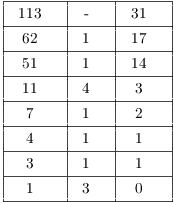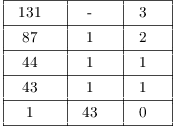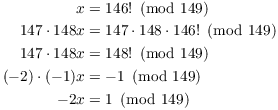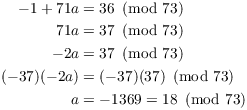Suppose p is prime. Wilson's theorem says ![]() . Fermat's theorem says if
. Fermat's theorem says if ![]() , then
, then ![]() . They are often
used to reduce factorials and powers mod a prime.
. They are often
used to reduce factorials and powers mod a prime.
I'll prove Wilson's theorem first, then use it to prove Fermat's theorem.
Lemma. Let p be a prime and let ![]() . Then
. Then ![]() if and only if
if and only if ![]() or
or ![]() .
.
Proof. If ![]() , then
, then ![]() . If
. If ![]() , then
, then
![]()
Conversely, suppose ![]() . Then
. Then
![]()
Since p is prime, ![]() or
or ![]() . The only
number in
. The only
number in ![]() which satisfies
which satisfies ![]() is 1, and the only number in
is 1, and the only number in ![]() which satisfies
which satisfies ![]() is
is ![]() .
.![]()
![]() means
means ![]() ---
that is, k is its own multiplicative inverse. So the result says that
1 and
---
that is, k is its own multiplicative inverse. So the result says that
1 and ![]() are the only numbers which are their own
multiplicative inverses mod p.
are the only numbers which are their own
multiplicative inverses mod p.
Theorem. (Wilson's theorem) Let ![]() . p is prime if and only if
. p is prime if and only if
![]()
Proof. Suppose p is prime. If ![]() , then k is relatively prime to
p. So there are integers a and b such that
, then k is relatively prime to
p. So there are integers a and b such that
![]()
Reducing a mod p, I may assume ![]() .
.
Thus, every element of ![]() has a reciprocal
mod p in this set. The preceding lemma shows that only 1 and
has a reciprocal
mod p in this set. The preceding lemma shows that only 1 and ![]() are their own reciprocals. Thus, the elements
are their own reciprocals. Thus, the elements ![]() must pair up into pairs
must pair up into pairs ![]() . It follows that their product is 1. Hence,
. It follows that their product is 1. Hence,
![]()
Now suppose ![]() . I want to show p is
prime. Begin by rewriting the equation as
. I want to show p is
prime. Begin by rewriting the equation as ![]() .
.
Suppose ![]() . I may take
. I may take ![]() . If
. If ![]() , the factorization is trivial, so suppose
, the factorization is trivial, so suppose ![]() . Then
. Then ![]() (since it's one of
(since it's one of ![]() ) and
) and ![]() , so
, so ![]() shows
shows ![]() . Therefore,
. Therefore, ![]() .
.
This proves that the only factorization of p is the trivial one, so p
is prime.![]()
Let's see how this works in a particular case. Take ![]() . Then mod 11 I have
. Then mod 11 I have

Notice how the numbers other than 1 and 10 paired up as a number and its multiplicative inverse, and how 1 and 10 are the only numbers which are their own multiplicative inverses.
Note that ![]() implies that p is prime
--- but this is not a very good way to test that a number is prime.
The factorials grow too rapidly.
implies that p is prime
--- but this is not a very good way to test that a number is prime.
The factorials grow too rapidly.
Theorem. (Fermat) Let p be prime, and suppose
![]() . Then
. Then ![]() .
.
Proof. Consider the set of integers
![]()
I'll show that they reduce mod p to the standard system of residues
![]() , then apply Wilson's theorem.
, then apply Wilson's theorem.
There are ![]() numbers in the set
numbers in the set ![]() . So all I need to do is show
that they're distinct mod p. Suppose that
. So all I need to do is show
that they're distinct mod p. Suppose that ![]() , and
, and
![]()
This means ![]() , so
, so ![]() or
or ![]() . Since the first case is
ruled out by assumption,
. Since the first case is
ruled out by assumption, ![]() . But since
. But since ![]() , this is only possible if
, this is only possible if ![]() .
.
Thus, ![]() are
are ![]() distinct numbers mod p. So if I reduce mod p, I must
get the numbers in
distinct numbers mod p. So if I reduce mod p, I must
get the numbers in ![]() . Hence,
. Hence,
![]()
On the other hand, another application of Wilson's theorem shows that
![]()
So ![]() , or
, or ![]() .
.![]()
Corollary. If p is prime, then ![]() for all a.
for all a.
Proof. If ![]() , then
, then ![]() and
and ![]() , so
, so ![]() .
.
If ![]() , then
, then ![]() .
Multiplying by a, I get
.
Multiplying by a, I get ![]() again.
again.![]()
Example. Reduce ![]() to a
number in the range
to a
number in the range ![]() . (Note: 83 is
prime.)
. (Note: 83 is
prime.)
If you multiply out ![]() , here's what you get:
, here's what you get: ![]()
![]()
![]()
![]()
![]()
![]()
![]()
Now just reduce mod 83. Heh.
If you don't have access to software that can do this, you can use
Fermat's theorem. First, 83 is prime and ![]() , so Fermat says
, so Fermat says ![]() .
.
Now
![]()
Hence,
![]()
In other words, if you're trying to reduce ![]() mod p, where
mod p, where ![]() , factor out as many
, factor out as many
![]() 's as possible, then reduce the rest "by
hand".
's as possible, then reduce the rest "by
hand".![]()
Example. Reduce ![]() to a
number in the range
to a
number in the range ![]() . (Note that 113 is
prime.)
. (Note that 113 is
prime.)
Since 113 is prime and ![]() , Fermat's theorem
gives
, Fermat's theorem
gives ![]() . So
. So
![]()
Next,

I need to compute ![]() .
.

![]()
Hence, ![]() . So
. So
![]()
Example. Compute
![]()
The any ten consecutive numbers, none divisible by 11, reduce mod 11
to ![]() . Hence,
. Hence,
![]()
Example. Simplify ![]() to a number in the range
to a number in the range ![]() .
.
By Wilson's theorem, ![]() . So
. So


![]()
It follows that ![]() , so
, so
![]()
Example. Simplify ![]() to a number in the range
to a number in the range ![]() .
.
Note: 149 is prime.
By Wilson's theorem, ![]() .
.

Now ![]() , so
, so
![]()
The next problem shows how you can often deal with composite moduli: Factor the modulus into a product of (powers of) primes, solve the problem relative to the prime (power) moduli, then combine the results using the Chinese Remainder Theorem to answer the original question.
Example. Find the least nonnegative residue of
![]() .
.
Note: ![]() .
.
I'll start by finding the residues of ![]() mod 71 and 73.
mod 71 and 73.
By Wilson's theorem,
![]()
Next, let ![]() . Then
. Then

Note that ![]() . So
. So
![]()
Thus,
![]()
I'll the the iterative method of the Chinese Remainder Theorem to get
a congruence mod 5183. First, ![]() means
means ![]() for some
for some ![]() . Plugging this into
the second congruence yields
. Plugging this into
the second congruence yields

The last congruence means that ![]() for some
for some
![]() . Plugging this into
. Plugging this into ![]() gives
gives
![]()
Copyright 2019 by Bruce Ikenaga